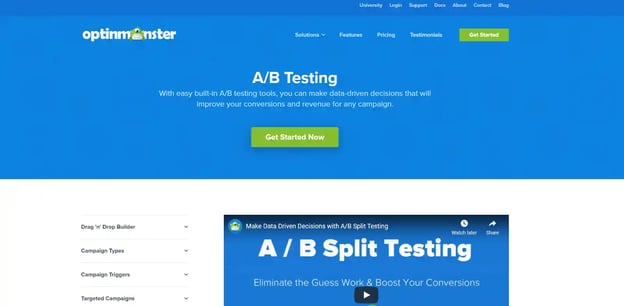If you're looking for something specific or in a bit of a hurry, use the jump links below to find exactly what you're searching for.
- The Basics of A/B Testing
- How does A/B Testing Work?
- 9 Best A/B Testing Plugins for WordPress
- What's the best A/B testing tool for WordPress?
The Basics of A/B Testing
An A/B test — also called a split test or A/B split test — is an experiment you can run to isolate a variable in your marketing campaign. The idea is that you pit one version of the variable against another (with all other elements remaining the same) and measure and analyze the performance of each.
Effective A/B testing can help you make data-driven decisions on all aspects of your marketing and sales campaigns, from messaging and aesthetics to email communications and advertising impact.
How Does A/B Testing Work?
Consider a marketing example. Let’s say you’re rolling out a new product and you’ve created two ads to help drive consumer interest, but aren’t sure which will deliver a better return on investment (ROI).
A/B testing can help. First, decide where you want to show these ads — Facebook, Instagram, via emails, etc. — and then determine your metrics. These might include the number of emails opened, the number of new visitors on your site, or the number of conversions. In practice, it doesn’t matter what the metrics are, just that they’re consistent across both tests.
Now you’re ready for the actual test. Start with your first ad, “A.” Run it on your platform of choice for a defined period of time — let’s say two weeks — and then record the results. Now, repeat the test with ad “B” while keeping all other variables the same. Use the same platform for the same length of time, and then measure the results.
Best WordPress A/B Testing Plugins
- Nelio A/B Testing
- Google Optimize for WordPress by Monster Insights
- Marketing Toolkit by OptinMonster
- VWO (Visual Website Optimizer)
- Split Test for Elementor
- Popups, Welcome Bar, Optins and Lead Generation Plugin by Icegram
- Split Hero
- Thrive Headline Optimizer
- ABtesting.ai
1. Nelio A/B Testing
Price: $24/month for Basic plan, $74/month for Professional plan, $216/month for Enterprise plan

Nelio A/B Testing negates the need for an external tool, offering a whole suite of split testing features natively in the back end of your WordPress site. With heatmaps, conversion action tracking, and even title testing, you can experiment with nearly all the elements of your site.
What we like about this plugin:
Nelio reduces the complexity of A/B testing by putting everything you need in the backend of your WordPress site. As a result, you don’t need to go looking for specific functions or have to find ways to route data back to WordPress since Nelio is fully integrated.
2. Google Optimize for WordPress by Monster Insights
Price: $100/year for Plus plan, $200/year for Pro plan, $400/year for Agency plan

Google Optimize is without a doubt one of the strongest A/B testing tools on the market. It allows you to play with a variety of elements on your site in a number of ways, including A/B, multivariate, and redirect tests. It also integrates with other Google products (such as Google Analytics) for a seamless experience.
The only downside is that it doesn't have a WordPress plugin. However, with the Google Optimize add-on for MonsterInsights, you can easily implement it on your site and benefit from all it has to offer.
What we like about this plugin:
The Google Optimize add-on for MonsterInsights lets you get Google A/B testing up and running with a single click. Simply download the add-on, input your Google Optimize Container ID and you’re ready to go.
3. Marketing Toolkit by OptinMonster
Price: $9/month for Basic plan, $19/month for Plus plan, $29/month for Pro plan, $49/month for Growth plan

OptinMonster is known for being a lead generation plugin that offers lightbox popups and other opt-in forms. However, OptinMonster also comes with A/B testing for those critical conversion elements on your site. This is in addition to its robust behavior-based personalization features that can help you as you improve conversions on your site.
What we like about this plugin:
By combining A/B testing with other solutions such as popups and opt-in forms, OptinMonster can help you figure out which ads are delivering the best results — and then serve them up directly to your targeted audience.
4. VWO (Visual Website Optimizer)
Price: Free

VWO is a powerful A/B testing platform that features a visual editor for you to make changes and set up variations without writing code. It also has advanced analytics capabilities and will make recommendations based on statistical significance. In addition, you can keep track of your hypotheses and their results. This software connects to WordPress with a convenient plugin.
What we like about this plugin:
VWO lets you test anything, anywhere, to measure its impact. The tool also tracks both leading and lagging indicators to help you see which marketing approaches are on the way up and which are starting to fall off.
5. Split Test for Elementor
Price: Free
Elementor is a popular page builder for WordPress sites. If you already have Elementor installed, this plugin is the perfect complement.
With Split Test for Elementor, you can test individual components or widgets against each other, or you can test whole pages. It also comes without bloated JavaScript and unnecessary coding that can increase page load times.
What we like about this plugin:
Split Test for Elementor is simple and streamlined, letting you test what you want when you want it without compromising performance. Add in the robust capabilities of the Elementor platform for building WordPress sites, and you’ve got a winner.
6. Popups, Welcome Bar, Optins and Lead Generation Plugin by Icegram
Price: Starts free, $97/year for Pro plan, $147/year for Max plan

Similar to OptinMonster, Icegram's value lies in its powerful conversion tools. You can implement popups, action bars, and more to aid your lead generation efforts and create powerful UX experiences.
However, Icegram knows the importance of testing in CRO and offers split testing for its features. You'll be able to experiment with opt-ins, headlines, CTAs, button colors, and more — the results of which can inform your strategy as you use Icegram to create even better opt-ins.
What we like about this plugin:
Customize your A/B testing to ensure you’re getting the most accurate and actionable results with Icegram, then leverage the tool’s robust feature set to build a better UX.
7. Split Hero
Price: $49/month for Basic Plan, $99 for Premium Plan, $249 for Agency Plan
 Split Hero lets you get started with WordPress A/B testing in just a few minutes. There’s no coding required and the solution is designed to be user-friendly so that anyone on your team can create, maintain, and manage tests.
Split Hero lets you get started with WordPress A/B testing in just a few minutes. There’s no coding required and the solution is designed to be user-friendly so that anyone on your team can create, maintain, and manage tests.
The result is an easy way to get A/B testing off the ground and see what really resonates with your audience — before you spend money on marketing campaigns.
What we like about this plugin:
Split Hero offers a free trial (no credit card required) to help kickstart your A/B testing. If you like what you see, a basic plan is just $49 per month.
8. Thrive Headline Optimizer
Price: $99 for Thrive Quarterly Plan

Thrive is all about headlines, which makes sense because headlines can make or break your emails and advertising efforts. If customers aren’t compelled by your headlines to click through, your marketing campaign won’t deliver, no matter how clever or interesting the rest of your efforts may be.
The Thrive Headline Optimizer uses A/B testing to pinpoint headlines that will elicit the best response from your audience.
What we like about this plugin:
The Thrive Headline Optimizer is part of the larger Thrive Suite which also offers a theme builder, quiz builder, and leader generator.
9. ABtesting.ai
Price: Free

This plugin also uses advanced AI to help with conversion optimization. What makes it unique is that it can test multiple variables at the same time, showing different combinations of elements until there's a clear, statistically significant winner for the page. This makes it a great option for marketers who need a set-it-and-forget-it solution where the machine does all the work.
What we like about this plugin:
AI is a marketer’s best friend. Given the number of options and outcomes for advertising efforts, having a tool capable of running multiple A/B tests simultaneously can help reduce workloads and provide actionable insights more quickly.
What’s the best a/b testing tool for wordpress?
It's important for your business to know what your users are looking for, what's resonating with them, and what's not so that you can generate leads and revenue effectively. Once you're equipped with the right A/B testing plugins, you can begin making informed decisions for growth.
So what’s the best A/B testing tool for WordPress? The answer depends on what you’re looking for. With a host of great options now available, it’s more a matter of which tool delivers the functions you need with the format you want — any of the nine tools we’ve listed above can help get your A/B testing off the ground and help you pinpoint the top performers in your next marketing campaign.
Editor's note: This post was originally published in January 2020 and has been updated for comprehensiveness
WordPress Plugins








